Daytona Beach Coquina Clock Tower facts for kids
Quick facts for kids |
|
|
Daytona Beach Clock Tower and Fountain
|
|
|
U.S. Historic district
Contributing property |
|

A full view looking from the northwest at the Daytona Beach Coquina Clock Tower after the rehabilitation project was completed. Note the pelicans that are flying overhead. They are a common site near the beach in the northeastern part of Florida.
|
|
| Location | Daytona Beach, Florida |
|---|---|
| Built | 1937 |
| Built by | Works Progress Administration |
| Architect | Alan J. MacDonough |
| Architectural style | Late Gothic Revival |
| Part of | Daytona Beach Bandshell and Oceanfront Park Complex (ID99000159) |
| MPS | Daytona Beach MPS |
| Designated CP | March 5, 1999 |
The Daytona Beach Coquina Clock Tower is a cool clock tower you can find in Daytona Beach, Florida. It's part of a bigger historic area called the Daytona Beach Bandshell and Oceanfront Park Complex. This whole area was added to the United States National Register of Historic Places in 1999. It's important because of its role in entertainment, recreation, city planning, and architecture.
Building the Clock Tower
Early History of the Park
The Oceanfront Park Complex, including the Clock Tower, was built between 1936 and 1937. It was made from concrete and a special type of rock called coquina. This rock is made from crushed shells and coral. The park was huge and had many cool features. These included small buildings, kiosks, a bathhouse, shops, game rooms, and even tunnels for people to walk through. The famous Daytona Beach Bandshell and its seating area were also part of this big project.
A Project During Tough Times
In the 1930s, Daytona Beach was going through a very tough time. This was during the Great Depression, when many people didn't have jobs or money. City leaders wanted to find a way to bring tourists back to the area. In 1934, the mayor, Edward H. Armstrong, and other city officials started trying to convince the government to help build a large outdoor park.
In January 1936, the project was approved. It would be built by the Works Progress Administration (WPA), a government program that created jobs. The city of Daytona Beach also had to contribute a lot of money. A talented local architect named Alan J. MacDonough, Sr., designed the entire complex. Building started in 1936, with WPA workers digging out tons of sand to prepare the area.
Building Challenges and City Drama
At first, workers made a big mistake. They used local beach sand and salt water to mix the concrete for the foundation. This caused the base to crack and crumble. They had to break up the bad concrete and start over. This time, they used clean fresh water and gravel, which was the right way to do it.
These delays caused money problems and led to questions from state officials. The Florida government, led by Governor David Sholtz, started looking into the project. The city's rules said that officials who spent too much money could be removed from their jobs. Because of this, Mayor Edward Armstrong and two other city leaders stepped down in December 1936. They even chose their wives to take their places!
Later that month, Governor Sholtz told Mayor Irene Armstrong (Edward's wife) and other city officials to step down too. He blamed them for the money issues. He even sent about 200 National Guardsmen to Daytona Beach to put new officials in charge and to get the city's money records.
About 100 local police and city workers barricaded themselves inside City Hall to protect Mayor Irene Armstrong and the other officials. A crowd of over 2,000 people gathered outside. It looked like there might be a fight! Luckily, a judge issued an order that stopped the new officials from entering the building. The Florida Supreme Court later agreed with the judge's order.
After a five-day standoff, the National Guardsmen and the crowds left. This event is now known as the "Battle of Daytona Beach." Because the governor's term ended and the new governor didn't want to continue the fight, Edward Armstrong and the other city officials were able to get their jobs back in March 1937.
Completing the Park
By the summer of 1937, most of the park was finished. The whole project cost over $300,000, which was a huge amount of money back then. Daytona Beach contributed about $84,000. The park complex was one of the biggest of its kind in the world at the time!
The park was dedicated on July 4, 1937. However, some parts of the park weren't fully ready, so the official dedication was held on January 1, 1938. Sadly, Mayor Edward Armstrong, who worked so hard to get the park built, died the very next day. WPA workers put up a monument in the park to honor him.
The Original Clockworks
The clock inside the tower was originally made by the Seth Thomas Clock Company. It was a special clock that ran for eight days before needing to be wound. It had a long pendulum and a heavy pendulum ball. It even had a clever system that would automatically rewind the weights when they got low. In the 1980s, the clock was updated to run completely on electricity.
Changes to the Park
1986-87 Redevelopment Project
Between 1986 and 1987, a new hotel was built, which changed Oceanfront Park. Many of the original buildings, like the small pavilions, kiosks, bathhouse, shops, and game rooms, were taken down. The old pedestrian tunnels were closed and filled in much earlier, in 1974. The parts of the original park that are still standing today are the Daytona Beach Bandshell, the Edward H. Armstrong Monument, and the Daytona Beach Clock Tower and Fountain.
52nd Anniversary Ceremony
The Clock Tower's 52nd Anniversary celebration was a big success, thanks to a man named Jack Smith. The clock had stopped working because it hadn't been taken care of, and bird droppings had gotten into the machinery. City officials thought it might never work again. But Jack Smith, who was an expert at fixing clocks, volunteered his time. He cleaned and repaired the clock, getting it working again just in time for the ceremony. On July 4, 1989, Daytona Beach Mayor Larry Kelly thanked Jack, saying, "You helped us do it. Thanks a billion."
Clock Tower Renamed
In 1989, the city of Daytona Beach decided to rename the Clock Tower. They wanted to honor Sir Malcolm Campbell, a famous race car driver. Sir Malcolm Campbell set many world land speed records right on the beaches of Daytona. This renaming happened after another street was renamed in honor of Dr. Martin Luther King Jr. The city wanted a lasting way to remember Campbell's amazing achievements.
Today, a bronze plaque is placed on a large coquina rock near the fountain. It says, "Sir Malcolm Campbell, Honoring his land speed record of 276.82 mph achieved on these sands in 1935. Daytona Beach City Commission, Mayor Baron ‘Bud’ Asher, Historic Preservation Board, Rededicated Sept. 27, 2002.”
Keeping the Tower in Good Shape
Assessment and Rehabilitation Project
The city of Daytona Beach hired a company called Renker-Eich-Parks Architects to check the Clock Tower. They wrote a report about its condition and what needed to be fixed. The report said that some of the coquina rock was worn away, and parts of the tower needed new mortar (the material that holds bricks or stones together). The entire structure also needed new electrical wiring to meet modern safety rules.
The report suggested many important repairs. These included fixing the mortar, replacing missing coquina stones, repairing concrete, and treating algae. They also needed to replace rusty fasteners, patch openings, and restore the spire (the pointy top part) and weather vane. All the old electrical items needed to be removed and replaced with new lights, wiring, and controls.
Even with all these issues, the report said the Clock Tower was in "fair condition" overall.
Because the historic Clock Tower had been getting worse for many years, the city applied for a grant to help pay for repairs. They received $231,000 for the project! $50,000 came from a state grant, and the city of Daytona Beach provided $181,000. The goal was to fix the tower without changing how people could access it. This project would help save the historic landmark and help more people learn about it.
The project was finished ahead of schedule in 2015-2016. Many new things were installed, and the tower's structure was repaired. New clock faces and hands were made by the Verdin Company. The clock faces are made from a see-through plastic, and the numbers are black. The hands are made from a light metal. The old clock movements were replaced, so now all four clock faces show the correct time!
Workers also fixed the mortar joints and replaced any missing coquina rock pieces. The decorative parts on the top of the tower were repainted. The entire tower was rewired, and new lights were put in both inside and outside. Lightning rods were added to the very top of the tower for safety. The fountain was also updated with a new motor and pump, and its surface was repaired.
Hurricane Matthew Damage
In October 2016, Hurricane Matthew caused some minor damage to the clock tower. One of the clock faces was broken, probably by something flying in the strong winds. The eagle on top of the weather vane was also blown off. A new clock face was made and installed in November 2016. The eagle was found, but it was too damaged to put back. A new weather vane was made and installed in April 2017. The clock's electrical parts were checked, and all four clock faces are still showing the correct time.



